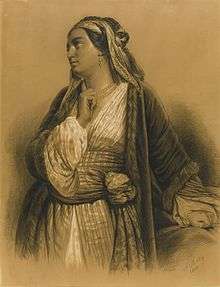Kyra Vassiliki

Kyra Vassiliki (Greek: Κυρά Βασιλική 1789 – 1834) was an influential Greek woman brought up in the seraglio of the Ottoman ruler Ali Pasha.
Life

Vassiliki Kontaxi was born in the Greek village of Plisivitsa in Thesprotia. At the age of twelve she sought an audience with the local Ottoman ruler, Ali Pasha, to intercede for her father's life.[1] Having granted her father pardon, Ali Pasha married Vassiliki in 1808 and she joined his harem.[1] Being allowed to practice her Christian faith, she interceded on behalf of Greeks.[1] In 1818 she became a member of the Greek patriotic organization Filiki Eteria. Vassiliki was directly recruited by one of the three founding members of the organization, Nikolaos Skoufas.[2] During this period she undertook a number of charity initiatives. In 1819–20 she financed a number of restoration works in Mount Athos.[3]
In January 1822, during the last stage of the siege of Ioannina by the Ottoman Sultan's forces, Vassiliki together with Ali Pasha and his private guard escaped to the Ioannina Island. Ali Pasha was executed there on January 22 by an Ottoman delegation, having being declared an outlaw by the Sultan.[4] Following Ali's death, Vassiliki was sent as a prisoner to the Ottoman capital, Constantinople. She was later pardoned and returned to Greece, which meanwhile gained its independence after the successful Greek War of Independence (1821–30).[1] In 1830, the Greek state gave Vassiliki a medieval tower in Katochi, where she lived the rest of her life.[5] She died of dysentery in 1834.[6]
In art and literature
In 1895, the gold-embroidered velvet purse of Vassiliki was bought by Nikolaos Konstantinidis for 25 drachmas.[7] Vassiliki was depicted by various artists. She is briefly mentioned in a number of 19th century novels such as in Alexandre Dumas' The Count of Monte Cristo[8] and by English author Richard A. Davenport in his The Life of Ali Pasha of Tepeleni, Vizier of Epirus.[9]
References
- 1 2 3 4 "Helley(?), H. Portrait of Kira Vassiliki. [1850]". Sotheby's. Retrieved 11 Aug 2015.
- ↑ Fauré, Christine (2004). Political and Historical Encyclopedia of Women. Routledge. ISBN 9781135456900.
But from 1818 on, the society began a very broad recruitment the included a certain number of women. Before his death, (note: in July 1818) Skoufas, one of the three founders of the society, suggested systematically contacting all women who, by their proximity to institutions of power, might be useful to the cause. He specifically mentioned the name of Vassiliki, the famous Greek mistress of the Albanian military leader Ali Pasha.
- ↑ Charitōn Monachos (1997). Maties ston Atho. p. 299.
A more recent benefactor was the Christian wife of Ali Pasha, Vassiliki, who largely financed the restoration of the monastery in 1819–1820.
- ↑ Bötig, Klaus (2006). Griechenland : Festland und Peloponnes [mit Reiseatlas & Routenkarten] (2., aktualisierte Aufl. ed.). Ostfildern: DuMont Reiseverl. p. 122. ISBN 9783770176083.
- ↑ "Koulia of Kyra Vassiliki". Kastrologos. Retrieved 11 Aug 2015.
- ↑ "Εκθέματα Προεπανάστασης - Κυρά-Βασιλική". Pavlos Vrellis Greek History Museum. vrellis.gr. Retrieved 13 September 2015.
- ↑ Maria Lada-Minōtou, I. K. Mazarakēs Ainian, Diana Gangadē, Greek costumes: collection of the National Historical Museum, Historical and Ethnological Society of Greece, 1993, p. xix
- ↑ Alexander, Dumas (2015). The Count of Monte Cristo. BookRix. ISBN 9783736801370.
- ↑ Richard A., Davenport (2012). The Life of Ali Pasha of Tepelini. Cambridge Scholars Publishing. ISBN 9781458924759.